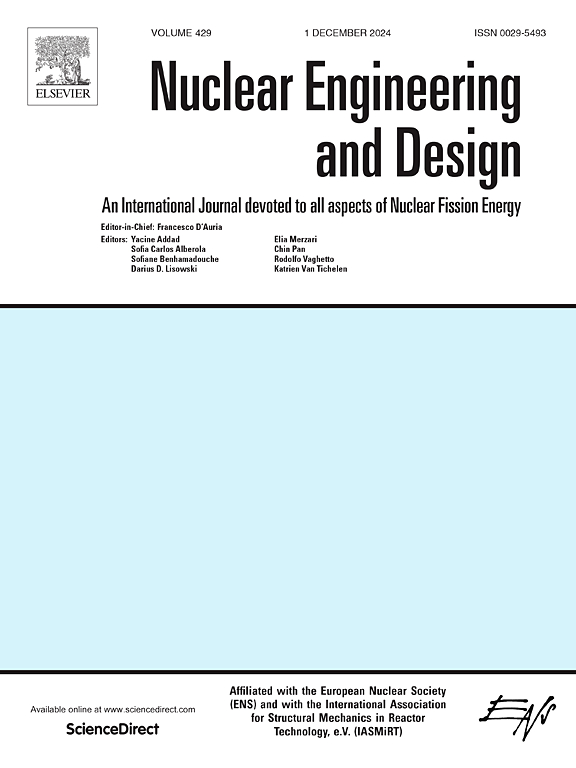SAFARI-1研究堆基准的中子不确定性传播:IAEA CRP T12029
IF 2.1
3区 工程技术
Q1 NUCLEAR SCIENCE & TECHNOLOGY
引用次数: 0
摘要
对SAFARI-1研究堆进行了全堆芯中子定量和灵敏度分析;感兴趣的输出参数是中子倍增因子keff。还研究了燃料元件的计算,以深入了解这个问题。采用了经济合作与发展组织关于轻水堆多物理场计算不确定性量化基准的计算方法。这项工作的范围限于反应堆物理(中子计算)。根据2016年国际原子能机构协调研究计划的SAFARI-1基准规范建造了五个核心模型。模型1为燃料元件(FE)模型,两侧为反射边界条件,轴向为空洞边界条件。模型2 - 4为全岩心模型,控制棒分别插入岩心的0%、50%和100%。模型5是仅由燃料元件组成的全核心模型。使用SCALE 6.2.3代码包中的TSUNAMI-3D进行不确定性传播。乘法系数keff的不确定度由灵敏度系数和协方差矩阵计算,采用“夹心法则”。从结果可以看出,无限燃料元件模型的keff的不确定性为0.490%,全堆芯模型的不确定性约为0.640%(最大值)。从灵敏度分析也可以看出,FE模型中不确定性的最大贡献者是由于每次裂变释放的平均中子数和(n, γ)反应。对于全堆模型,贡献最大的是每次裂变的平均中子数和裂变谱chi的不确定性。详细的行为的个别贡献者的不确定性也进行了调查。还发现反应堆堆芯的大小影响各个贡献者的价值。在较小程度上,反应堆堆芯的非均质性也影响单个贡献者的价值。研究了不同尺寸核芯的中子通量分布,因为它有助于chi的不确定性,以及中子的重要性,观察chi和nubar各自的不确定性贡献的趋势。本文章由计算机程序翻译,如有差异,请以英文原文为准。
Neutronic uncertainty propagation for the SAFARI-1 research reactor benchmark: IAEA CRP T12029
Quantification of full core neutronic and sensitivity analysis of the SAFARI-1 research reactor was performed; the output parameter of interest was the neutron multiplication factor keff. Fuel element calculations were also studied to gain insights into the problem. The calculational approach in the Organization for Economic Corporation and Development benchmark for quantification of uncertainties in multiphysics calculations for LWRs was followed. The scope of the work is limited to reactor physics (neutronic calculations). Five core models were built in line with the SAFARI-1 benchmark specifications, of the 2016 IAEA Coordinated Research Programme. Model 1 was a Fuel Element (FE) model with reflective boundary conditions on the sides and void boundary conditions axially. Models 2 – 4 were full core models with control rods at 0 %, 50 % and 100 % insertion in the core. Model 5 was a full core model consisting of only fuel elements.
TSUNAMI-3D, which is part of the SCALE 6.2.3 code package, was used for uncertainty propagation. The uncertainty in the multiplication factor keff is calculated with the sensitivity coefficients and the covariance matrix using the so-called “sandwich rule”. It can be seen from the results that the uncertainty in keff is 0.490 % for the infinite fuel element model and about 0.640 % (highest value) for the full core model. It is also seen from the sensitivity analysis that the highest contributors to the uncertainty in the FE model are due to the average number of neutrons released per fission and due to the (n, gamma) reactions. For the full core model, the highest contributors are uncertainties due to the average number of neutrons per fission and that due to the fission spectrum, chi. A detailed behaviour of the individual contributors to the uncertainty is also investigated. It was also found that the size of the reactor core influences the value of the individual contributors. To a lesser extent, the heterogeneity of the reactor core also influences the value of the individual contributors. The neutron flux distribution in cores of different sizes was also studied since it contributes to the uncertainty due to chi, as well as the neutron importance, to observe the trend in the individual uncertainty contributions of chi and nubar.
求助全文
通过发布文献求助,成功后即可免费获取论文全文。
去求助
来源期刊

Nuclear Engineering and Design
工程技术-核科学技术
CiteScore
3.40
自引率
11.80%
发文量
377
审稿时长
5 months
期刊介绍:
Nuclear Engineering and Design covers the wide range of disciplines involved in the engineering, design, safety and construction of nuclear fission reactors. The Editors welcome papers both on applied and innovative aspects and developments in nuclear science and technology.
Fundamentals of Reactor Design include:
• Thermal-Hydraulics and Core Physics
• Safety Analysis, Risk Assessment (PSA)
• Structural and Mechanical Engineering
• Materials Science
• Fuel Behavior and Design
• Structural Plant Design
• Engineering of Reactor Components
• Experiments
Aspects beyond fundamentals of Reactor Design covered:
• Accident Mitigation Measures
• Reactor Control Systems
• Licensing Issues
• Safeguard Engineering
• Economy of Plants
• Reprocessing / Waste Disposal
• Applications of Nuclear Energy
• Maintenance
• Decommissioning
Papers on new reactor ideas and developments (Generation IV reactors) such as inherently safe modular HTRs, High Performance LWRs/HWRs and LMFBs/GFR will be considered; Actinide Burners, Accelerator Driven Systems, Energy Amplifiers and other special designs of power and research reactors and their applications are also encouraged.
 求助内容:
求助内容: 应助结果提醒方式:
应助结果提醒方式:


